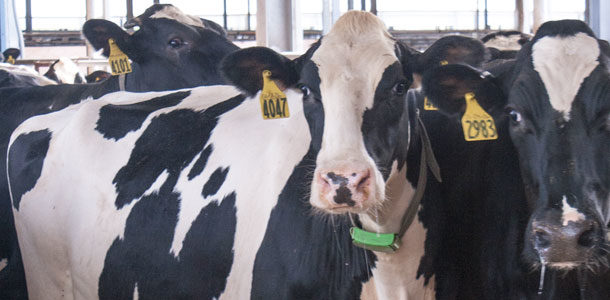When they were first introduced a decade or more ago, fresh cow monitoring protocols were new in scope and design. Progressive producers quickly implemented these practices to track every cow after calving, diligently taking daily temperatures, noting physical signs of metabolic disorders, employing drenching or other treatment protocols as needed and spending lots of time with these animals each day.
At the time, these strategies made perfect sense. The transition period was a concern for many dairies, and these actions seemed to be the best way to intensively manage the most vulnerable cows. These animals deserved the extra attention, and dairies generated hard drives full of transition health data while improving their fresh cow care.
At the same time, these fresh cow protocols required producers and their teams to monitor each and every cow, each and every day. And these protocols often interrupted daily transition cow routines and behaviors.
Producers have come to learn there’s a better, more efficient way to monitor fresh cows – or any cow that requires attention – and intervene in an extremely targeted and efficient manner.
Herd experience
A 4,000-cow California herd was fully vested in a full-scale transition monitoring program and had been for years – with excellent results. The dairy ranked above industry average in milk production, milk quality and reproductive performance.
But the program required two people to take daily cow temperatures for a number of days after calving for every fresh cow. Depending on the number of calvings, these employees examined 110 to 200 cows daily, and protocol tasks took three to four hours to perform.
This well-managed operation felt new technology would allow them to improve cow care and efficiency while reducing costs.
This led the dairy to invest in an animal monitoring system that featured rumination monitoring, as well as activity monitoring, to help focus attention on cow health and performance. It also provided the ability to hone in on animals that require timely interventions, thanks to predictive data from the system.
Scientific backup
Repeated research results verified their decision. For example, research published in the December 2012 Journal of Animal Science clearly demonstrated that cows with reduced rumination before calving also experienced reduced rumination time after calving and suffered a greater frequency of disease than cows with greater rumination time in late pregnancy.
Therefore, by monitoring this parameter, dairies can rapidly identify pre-calving animals that would likely require a postpartum management intervention.
In addition, recently unpublished data from Cornell University shows that animal monitoring systems reliably indicate an incidence of a displaced abomasum as many as three days prior to physical symptoms. Cases of ketosis were evident via the system about a day-and-a-half before physical symptoms appeared, while cases of general stomach upsets were apparent about a half-day earlier than that with visual observation.
The technology improves cow care regardless of a dairy’s management philosophy. Researchers note that for operations currently performing few interventions during the transition period, animal monitoring systems help them identify cows with health disorders to improve overall transition period health and performance.
Further, the reliability of the monitoring systems enables farms that already have intensive transition programs in place to reduce their labor cost and cow handling by enabling users to successfully target animals that require intervention.
In addition, yet-to-be-published results from the University of Minnesota also show a clear, linear relationship between the prevalence of subclinical ketosis and inconsistent pre-fresh rumination. Similarly, inconsistent pre-fresh rumination is also related to increased prevalence of subclinical hypocalcemia.
In other words, as rumination decreases or fluctuates before calving, the risk of metabolic disorders increases. The research further supports the premise that it’s not the number of rumination minutes per day that’s important to monitor – it’s the deviation in rumination minutes per day dairies must monitor for individual animals for targeted interventions and on a group or herd basis for larger management decisions.
Immediate on-farm results
Shortly after installation, the California dairy began to reap results. By monitoring rumination variation, the herd manager was able to quickly single out any animals requiring attention.
Instead of needing to examine 150 cows each day, many of which were perfectly healthy, his team could spend their time with the 30 to 50 cows (again depending on number of calvings) that needed the extra attention. The transition team could then target their interventions to meet individual cow needs.
Instead of using the previous lengthy, complicated cow lists, the herd manager now simply pulls a daily fresh cow report that shows rumination performance. The report flags animals with deviations in rumination time for further attention, and the transition team can implement treatment protocols as needed.
This streamlined process dramatically reduced the time cows spent in headlocks – down to less than an hour each day. This means more time for animals to go about their natural feeding and lying behaviors. It also enabled the cows that didn’t require attention to skip this time in headlocks altogether.
Plus, treatment cost for fresh cows was cut in half. The dairy also noted an uptick in feed intake, largely due to cows spending less time in headlocks thanks to the monitoring system.
The dairy also modified pen moves after watching rumination time fluctuate – particularly for cows that were in the hospital pen for some reason.
Prior to the animal monitoring system, the cows would have been moved back to their milk pen when her temperature or appearance was improving. But oftentimes the cow would regress after the move and would be moved back to the hospital.
Now, by watching rumination data, the herd manager can determine when the cow’s rumination time is optimal. The dairy adds a day or two in the hospital pen to confirm health status, then she is returned back to her milking pen.
All of these changes resulted in healthier cows that more easily transitioned to their next lactation.
The dairy also reported significant improvements in its reproductive program thanks to the monitoring system. Improved prefresh and fresh cow health and better heat detection due to accurate, constant monitoring resulted in reduced days open and fewer cows enrolled in synchronization protocols. Instead of the entire herd, now only those that require an intervention are enrolled.
Instead of 60 to 65 percent of cows pregnant at preg checks, now 70 to 75 percent are pregnant at preg checks. The dairy’s 21-day pregnancy rate also rose from 22 to 26 percent. These results show healthier cows breed back more quickly.
Ultimately, the opportunity to target which cows required extra attention resulted in improved performance for these individual animals and the dairy as a whole. PD
References omitted due to spacebut are available upon request. Click here to email an editor.
PHOTO
Ultimately, the opportunity to target which cows required extra attention resulted in improved performance for these individual animals and the dairy as a whole. Photo by Walt Cooley.

Shane St. Cyr
Field Support Manager
SCR Dairy Inc.







